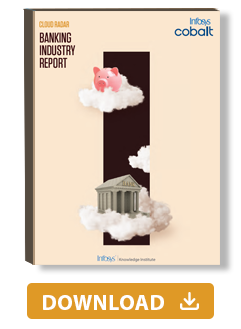Insights
- Banks have been cautious in moving critical systems and data to cloud systems.
- Competition from nonbank financial technology companies is driving banks to use cloud to tap into new technology and innovation.
-
-
Banks intend to use cloud to scale up their data and AI efforts with key goals of
- Improving customer experience
- Increasing efficiency for knowledge workers and customer service specialists and
- Innovating product design
Executive summary
Banks, by their nature, are slow to change.
For good reasons, bank executives generally advance cautiously rather than rushing to fully embrace the most promising innovations. Changing their technology is more involved than in other industries due to regulatory, security, and customer privacy requirements. For example, banks generally started using cloud at about the same time as businesses in other industries — about a decade ago — but in more limited ways, executives say. Now, cloud has changed in the banking industry: Its uses and capabilities have grown more complex. Across all industries, cloud has entered a new era of growth and innovation.
Banks now are exiting longstanding data centers and shifting more of their data and workloads to cloud. This is doubly challenging for banks, given the sensitivity of their data, but it is also a critical and timely one. Banks are expected to increase their cloud spending in the coming year, according to Infosys’s Cloud Radar report.
Cloud Radar surveyed more than 2,500 respondents from companies across nine industries — in Australia, France, Germany, New Zealand, the UK, and the US, and in the Nordic countries, including Denmark, Finland, Iceland, Norway, and Sweden. The study surveyed 399 respondents from banks in those regions.
The research found that banks depend on cloud for sophisticated solutions, growth, and transformation. They use cloud most frequently for loan origination and underwriting, and for operating cards and payment systems. Banks are happy with the results delivered by cloud but also face challenges when it comes to cloud usage and cost.
With intense competition from nonbank financial technology companies, getting cloud right is critical for traditional financial institutions. This means going deeper with cloud than just upgrading customer-facing applications and using cloud to tap into new technologies more quickly. New technologies delivered via cloud, including applied artificial intelligence (AI), can enable banks to improve customer experiences, deliver better service, and develop new products.
In the next six to 18 months, data and AI will be a key incentive for banks to shift to cloud, says Dennis Gada, Infosys executive vice president and financial services segment head. The generative AI phenomenon of 2022 showed banks the potential to use AI to unlock value in their data. They conducted experiments and proofs of concept in the last year and in early 2024. Finally, it’s time to put that potential to work. “Now everybody wants real scaling up of data and AI via cloud,” Gada says.
Infosys experts identified three domains where banks will focus data and AI efforts:
- Improve customer experience.
- Increase efficiency for knowledge workers and customer service specialists.
- Innovate in product design.
Cloud will play a critical role for banks in the coming six to 18 months as they work to harness the power of data and artificial intelligence.
The big challenge and motivation for new cloud efforts is that bank data remains heavily in on-premises servers, which limits its usefulness. AI systems built on-site are expensive to establish and operate, so data must be migrated to cloud or efficiently linked to cloud where AI tools can unlock their value.
More critically, banks that can’t meet customer demands for modern services where they are will face an existential crisis. Banks shouldn’t expect customers to stay out of loyalty.
“If their system can’t cope with the way people want to consume banking services, banks will quickly see customers depart,” Gada says.
Smashing data centers and shifting systems to cloud
In 2022, Comerica Bank marked its shift to cloud with creativity and catharsis: Employees played hockey in a decommissioned on-premises data center and smashed outdated server racks and hardware.
Comerica leaders removed batteries and storage media, so that nothing dangerous was spilled and no customer data was exposed before the smash party. But taking hockey sticks to equipment that the company had relied on for nearly three decades was symbolic of its latest work. Moving to the cloud required bold action and ambition.
Banks must account for hundreds of security, regulatory, and access controls and procedures. Changing fundamental, underlying technology requires a re-examination of all those systems. So, progress happens slowly.
But as the banking business evolves away from vaults and notes and toward mobile apps and electronic payments, new technology delivered by cloud has become critical.
Banks and related institutions, including credit unions, are in the business of trust, says Anurag Sharma, chief technology officer at VyStar Credit Union in Jacksonville, Florida. “There's a huge amount of responsibility in managing their financial data, managing risk, ensuring regulatory compliance,” he said in an Infosys Knowledge Institute podcast interview. “The primary focus of technology in financial services is on delivering a seamless experience while doing it safely.”
Cloud is for loans and payments systems… and it’s working well
While the industry’s migration to advanced capabilities started late, cloud is working well for banks. Of 399 banking businesses surveyed by Infosys, 75% say cloud migration efforts are very effective or extremely effective (Figure 1). That’s in line with most large companies in our survey.
Figure 1. Cloud migration is meeting companies’ expectations
Source: Infosys Knowledge Institute (N=399)
Bank executives say they are currently moving to cloud for growth and transformation (Figure 2). More specifically, they turn to cloud to integrate acquisitions or subsidiaries, access new technologies, enable new revenue streams or products, and replace or update outdated systems.
Figure 2. Banks want growth and transformation from cloud
Source: Infosys Knowledge Institute
Companies think about cloud differently today, says John Wei, former chief technology officer at Comerica Bank. Where early cloud focused on replacing physical computer infrastructure with virtual boxes, the new era of cloud is centered on applications and capabilities.
“We're still talking about cloud. But we're no longer talking about boxes. We're no longer talking about servers, but we're actually talking about capabilities,” he said in a podcast interview with the Infosys Knowledge Institute.
High-level capabilities today require composable architecture that spans many clouds, prompting two big shifts, Wei says. First, the network and orchestration of cloud applications and ecosystems is more important. Second, companies have begun to re-think how they procure cloud services.
VyStar’s Sharma says he is focused on using technology to deepen customer or member relationships. That requires data, AI, cloud, and DevOps to create hyperpersonalized experiences and deploy new business capabilities quickly.
Bank executives tell us they use cloud most frequently for loan origination and underwriting, and for managing card payments and payment systems. Banks are unlikely to use cloud for fraud prevention and risk management, survey results show.
This is a missed opportunity because cloud is an ideal way to bring an embarrassing volume of computing power to risk analysis, says Ramesh Maran, Infosys associate vice president and global cloud head for financial services.
The fine-grained risk insights this can produce include real-time calculations of value-at-risk, complex risk calculations like composite risk ratings, and counterparty credit valuation adjustments.
“If you think about the complexity of a modern bank, especially a large American bank, and you think of all the different components that make up what could be at risk, you need a huge amount of computer power and data analytics,” he says.
Modern cloud is an ideal way to bring an embarrassing volume of computing power to risk analysis and other critical banking functions.
Use cases will continue to evolve, especially with the growth of AI and generative AI, delivered via cloud, Infosys’s Gada says.
“Turning to cloud to modernize legacy systems is a critical step for banks,” Gada says. “Modern cloud will enable banks to deliver better customer experience and bring innovation into their strategy.”
One impact of transformation and innovation is cost savings, notes Andrew Groth, Infosys executive vice president and industry head for the Asia-Pacific region.
“It gives them the ability to do things faster, more accurately, with less money or less operation cost,” Groth says. “In a roundabout way, it boils down to making things more operationally efficient.”
Bank cloud spending average now and projected to grow
Our research found that banks spend on average $33 million annually for cloud services, in line with our global average (Figure 3).
Figure 3. Banks spending on cloud is about average
Source: Infosys Knowledge Institute
Bank executives tell us they have increased cloud spending, and this trend will continue in the year ahead (Figure 4). In fact, when compared to other industries, banks were more likely to have increased spending on cloud last year, and they are also more likely to increase spending on cloud in this next year.
Figure 4. Cloud spending continues to increase for banks
Source: Infosys Knowledge Institute
As cloud systems develop additional capabilities, companies increasingly turn to cloud to replace outdated technologies and add new functionality, survey results show.
While banks are ready to spend on new cloud capabilities, many aren’t using all the cloud that they have already committed to. Our survey found that banks have consumed only 49% of the cloud they have committed to (Figure 5).
Figure 5. A majority of cloud commitments are unused
Source: Infosys Knowledge Institute (N=399)
“Cloud can become very expensive very quickly,” says VyStar’s Sharma.
His technology organization has regular cloud spending reviews and established spending thresholds that prompt extra scrutiny.
“We actively monitor and manage cloud spend as it is crucial to ensure that teams are optimizing costs and staying within budget,” he says.
A decade on, corporate cloud has changed
The nature of corporate cloud has changed. Most companies, including banks, began their cloud journey a decade ago. The prime era of initial cloud migration was 2012 to 2014 (Figure 6). Those first steps were typically about adding storage and replacing outdated tech infrastructure.
Figure 6. The prime era of initial cloud migration began more than 10 years ago
Source: Infosys Knowledge Institute
Today, cloud is not about infrastructure or storage, and it’s a singular noun. Cloud is multicloud, and most often hybrid multicloud.
Further, the way customers use cloud today has changed, says Anant Adya, executive vice president and head of Americas delivery. As cloud capabilities have grown and companies use cloud for more tasks, it becomes increasingly important to develop standards and reference architectures, he says.
Most banks employ three to four cloud providers today. In 2021, Infosys found that most companies used two or three cloud providers, and 21% lived in a monocloud world. In 2023, the monocloud community for banks is down to 9% (Figure 7).
Figure 7. Banks most frequently use three or four cloud service providers
Source: Infosys Knowledge Institute
“Everything is new in cloud. When you use reference architectures, business blueprints, and you actually do not reinvent the wheel every time you do it, it becomes much easier.”
– Anant Adya, executive vice president and head of Americas delivery.
More sophisticated cloud leads to new challenges
Cloud works well and delivers on increasingly sophisticated tasks. But as cloud systems have advanced, additional complexities are emerging.
Our research reveals that retail cloud managers are generally confident in their ability to run their systems. However, they are least confident in monitoring, predicting, and optimizing cloud costs (Figure 8).
Figure 8. Banks often struggle to manage cloud costs
Source: Infosys Knowledge Institute
As banks continue down the multicloud route, cost awareness and control become more and more important because the complexity has gone up exponentially.
“It’s not one system they have to manage — it’s actually 22 complete parallel sets of systems and maybe even touching things they have on-premises,” says Groth. “It gets incredibly complex, so being able to put a single pane of glass over your overall IT spend is the nirvana state.”
While that state of nirvana is not quite attainable, systems integration firms are working toward it.
Wei notes that upcoming cloud innovations will also accelerate progress toward better cost clarity around cloud.
“As we move higher and higher in the value chain, the notion of pricing by transaction will become more tangible and real,” he says. “I do think that the conversation in five years is going to be quite different.”
In addition to managing cost, sophisticated cloud systems can open up new security challenges. Our research found that 42% of banking respondents allow any department head or IT manager to deploy new cloud infrastructure, software, or applications (Figure 9). This might be too lax from a security perspective but must also be balanced against dynamic, changing business demands.
Figure 9. 42% of banks allow any department head to provision new cloud
Source: Infosys Knowledge Institute
VyStar’s Sharma says an updated cloud architecture, featuring microservices and modern APIs, is critical for properly managing complex hybrid multicloud systems.
“So, these will need to work together now, and more importantly, in the future as the workload shifts between different clouds and different platforms,” he says.
Cloud today is a domain where business and IT must operate in unison. Modern cloud requires many things to work together smoothly, demanding both technical and strategic thinking.
The trouble is, when we asked about a range of critical cloud decisions, 44% are made in isolation (Figure 10). Consider this new era of cloud — cloud saturates every corner of the corporate enterprise. Decisions about cloud need to involve leaders, technologists, and users.
Figure 10. 44% of key cloud decisions are made in isolation
Source: Infosys Knowledge Institute
IT and business must collaborate to ensure that cloud initiatives are successful and meet business objectives and mitigate risks. Cloud started as a solution that primarily required IT, but modern cloud touches every function of a business and its customers.
“I think the hardest part of cloud is getting the organization mobilized and marching toward a shared mission,” Wei says.
VyStar’s Sharma says engagement early and often between business and IT leaders will foster that sense of a shared mission. As a result, business execs will see technical leaders as more of a partner than an implementer or order taker.
“Another important thing is to deliver value quickly and build credibility,” Sharma says. “So instead of long-running projects, delivering new capabilities that function every few months in an incremental manner builds the confidence in technology.”
Large organizations are turning to APIs to link older mainframe systems to extract information and transform it into valuable insights in the cloud.
Due to that time pressure, a lot of major banks are shunning larger mainframe transformations because they are time-consuming, cost a lot of money, and carry big risks, says Jay Nair, Infosys executive vice president and financial services segment head for Europe, the Middle East, and Africa.
“The larger banking organizations are trying to build APIs on top of mainframe systems so that they can extract the information and use it,” he says.
That will be the status quo until AI tools advance and can automate data migration from mainframes.
“I think there will be some surrounding work of APIs and all to make the best use of data,” he says, “but beyond that I don’t think it’s going to happen immediately.”
Appendix: Research approach
Qualitative interviews
To enrich insight, we conducted phone interview with more than 50 industry practitioners, executives, and subject matter experts.
Quantitative survey
Quantifying unused cloud commitments
The unrealized revenue figure of $300 billion is based on the declarations made by cloud service providers in their latest 10-K (or 20-F filing in case of foreign listed companies) to the Securities and Exchange Commission (SEC). To arrive at the unrealized revenue value, we searched for the following declarations in the liability section of the SEC filings of the company’s balance sheet: "unearned revenue," "deferred revenue," or "backlog revenue." Most of the cloud provider companies have declared these values as a part of a short-term or long-term liability on their balance sheets depending upon the status of the contracts involved.
For the estimation, we recorded and then added the unrealized revenues for the cloud services providers covered in our study based on their SEC filings. We only included B2B unearned, deferred, or backlog revenue, and excluded any declared unrealized revenue listed as a liability due to B2C subscriptions or services. For example, Microsoft Xbox and other personal subscriptions was recorded under personal cloud subscription services was not included in our data analysis. Our research indicates that this $300 billion represents 53% of currently contracted cloud services. From this we estimate that the total amount of currently contracted cloud services exceeds $600 billion. Companies and their providers estimate the remaining $300 billion in unused cloud commitments will be consumed in the next three to five years but will likely be renegotiated and blended into a larger figure for longer contract terms.
Respondents by firmographics
Author
Chad Watt | Infosys Knowledge Institute, Dallas
Analysis and production
Isaac LaBauve | Infosys Knowledge Institute, Dallas
Pramath Kant | Infosys Knowledge Institute, Bengaluru
Indranil Chakrabarti | Infosys Financial Services, Raleigh
Vijay Rathore | Infosys Financial Services, London
Divyanshu Tiwari | Infosys Financial Services, Dallas


















